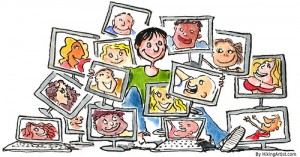 Just one click and suddenly I had invited 648 people—many of them strangers– to join my LinkedIn network. As my computer screen madly scrolled with acceptances, I sat there embarrassed by my new, elite networking status—I now belong to the 500+ connections club.
Just one click and suddenly I had invited 648 people—many of them strangers– to join my LinkedIn network. As my computer screen madly scrolled with acceptances, I sat there embarrassed by my new, elite networking status—I now belong to the 500+ connections club.
Just as I had been duped by Facebook years ago, allowing them to access my email list and invite people to see my photos, LinkedIn had now hoodwinked me in a similar fashion.
After years of politely asking strangers seeking to connect how it was that I knew them, I now looked guilty of prostituting myself to hundreds of people for the sake of appearing really connected. Ugh.
Nor did I customize any of the 648 invites, avoiding the generic “I’d like to add you to my network” wording—something I had done consistently in the past in an effort to make my invitations more personal.
What stood out was the number of people who said yes. In under 10 minutes, I got 80 acceptances. Many were from people I recognized, but some were not—they were connections of my connections, basically strangers. By the third day of my Linking experience, I had over 200 acceptances, and the LinkedIn sidebar told me I was now connected to more than 10 million professionals. That means I supposedly “know” more people than the entire population of New Jersey, the 11th most populated state in the U.S.
This Pavlovian response to LinkedIn invitations defeats the entire idea behind creating an effective network. Only two people wrote and questioned the invitation and in both cases I explained my mistake and suggested they decline. Everyone else either blindly clicked “accept” or ignored the invite. In a handful of cases people used it as a sales opportunity: how can we help you?
Whether you are gaming the system or not, mining emails to grow your network through other people’s second and third connections is diluting the benefit of LinkedIn. If someone sees that I am connected to a venture capitalist and asks for a warm introduction, am I going to do that for a complete stranger? No.
What about the 37 people who looked at my profile in the last three days? Did the people I worked with 10 years ago wonder if I was desperate? How about the associate at CBS News, did he wonder if I was not so subtly waving a flag in his face for a story? Well I wasn’t, but I would love to hear from you if you are reading this.
LinkedIn is a great tool when used like an in-person network, facilitating our human desire to easily connect and help one another. If I know you and I value you, I will try and deliver for you. For this type of online networking to work effectively, we have to keep it real and not just go for wholesale connections via spamming emails.
Anyone who falls into the clutches of LinkedIn’s scamming trap, be sure and go to your profile, click connections and manually delete each connection. You don’t want annoying reminders to make it look like you may have meant that suggestive look-at-me invitation.
Photo credit: by HikingArtist.com